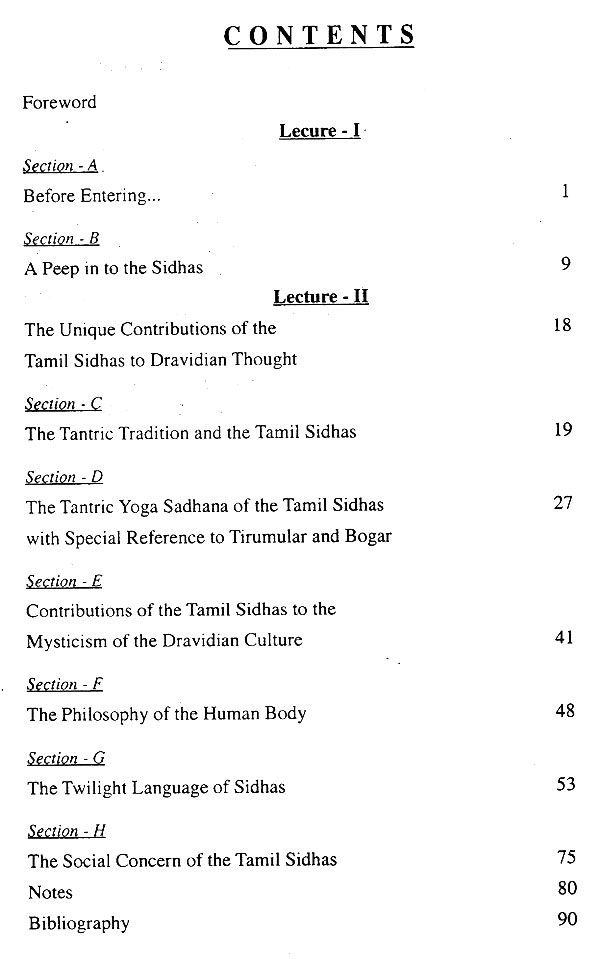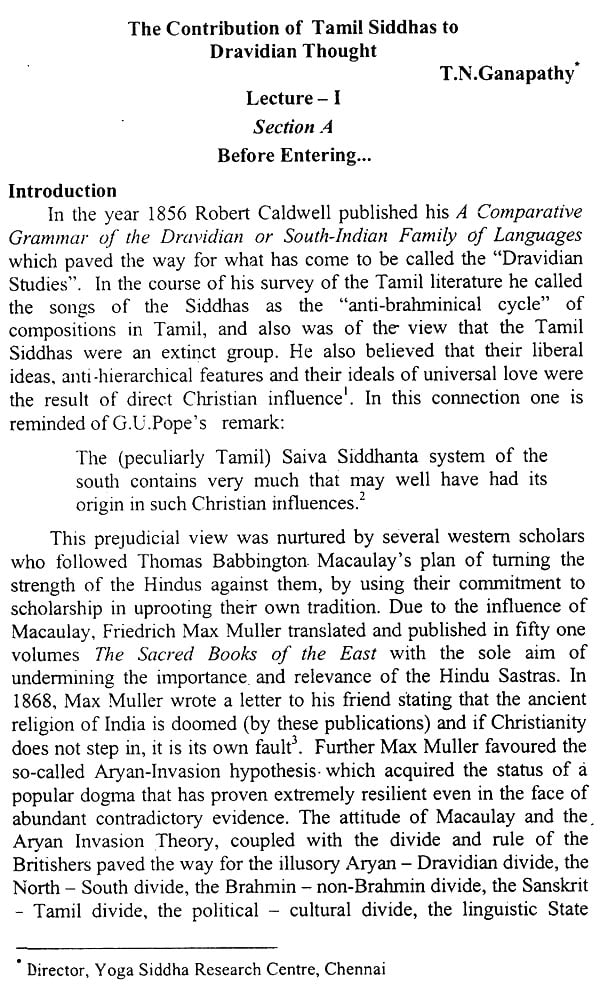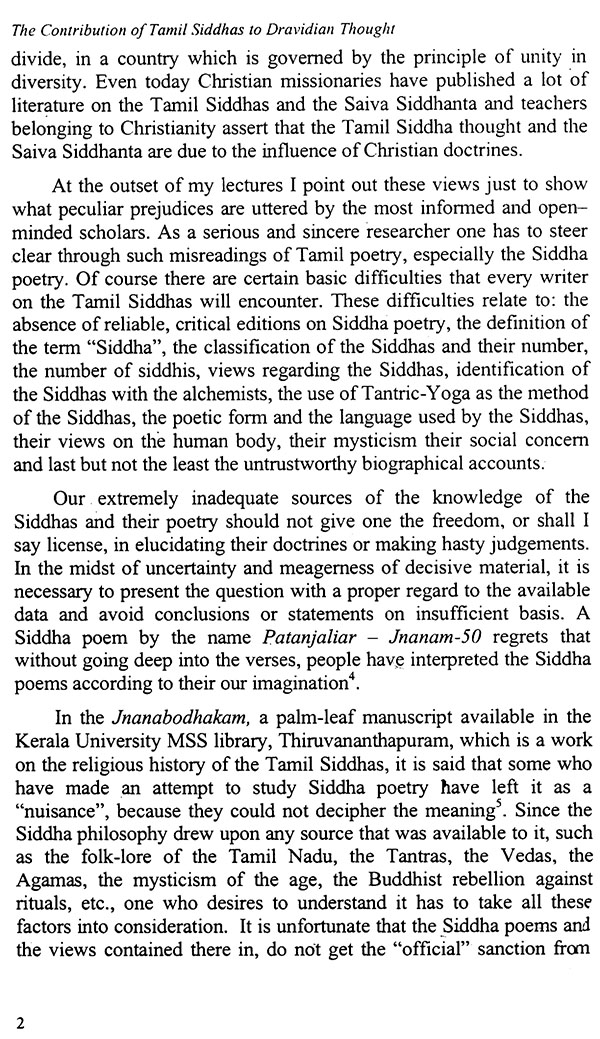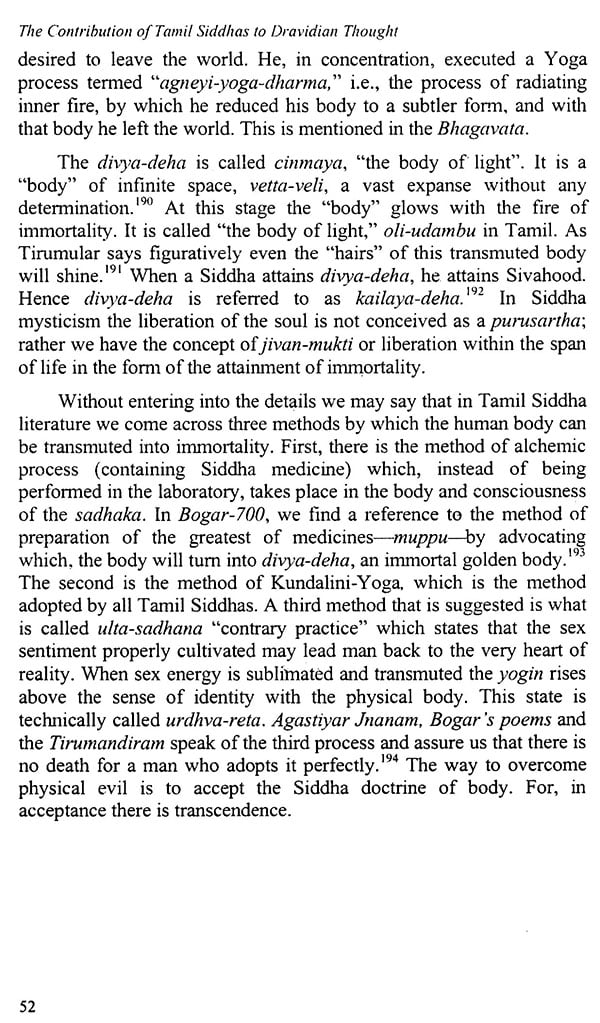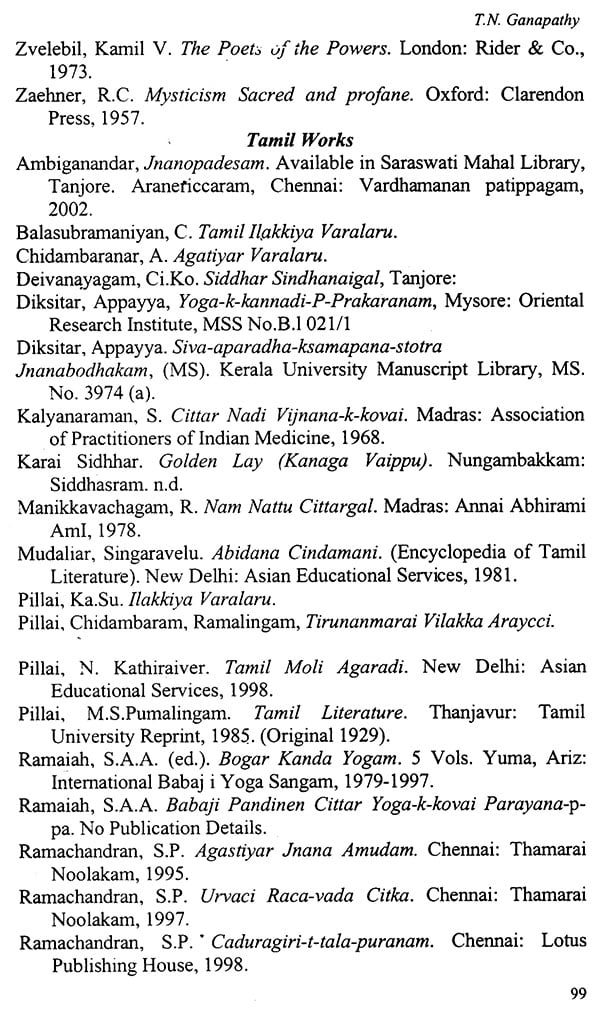
The Contribution of Tamil Siddhas to Dravidian Thoughts
Book Specification
| Item Code: | NAX106 |
| Author: | T.N. Ganapathy |
| Publisher: | Dravidian University Campus |
| Language: | English |
| Edition: | 2008 |
| Pages: | 100 |
| Cover: | PAPERBACK |
| Other Details | 9.00 X 6.00 inch |
| Weight | 140 gm |
Book Description
Dr. T.N. Ganapathy in this thoroughly researched work presents, without making hasty judgements, the quint essence of Siddha philosophy balancing its social and spiritual attitudes. A new thesis defining Siddha thought and enriching 'Dravidian' concept.
That the foundations of Indian culture were deeply embedded in Dravidian culture is now an incontrovertible fact. Dravidian culture is one of the most ancient cultures of the world. Those cultures, slightly contemporaneous to one another, slowly started fading out. However, the primordial Dravidian culture continues to thrive without losing its quintessence despite the apparent changes in systems of dress and address.
Dravidian University was established in 1997 to mirror the real and rich picture of Dravidian culture not only in its linguistic, literary, cultural and philosophical facets but in science and technological angles also.
The spirit of integration is the guiding force behind the creation of the University. The linguistic and cultural integration, not at the regional but at the national level is the cherished objective of the University.
The Government of Andhra Pradesh started Dravidian University, with the co-operation of the sister States, to research and reflect on the inherent oneness of the cultures of Dravidian family the four States whose languages number up to 27. Its endeavour is to promote unity and amity in the family of several languages. The main objectives of Dravidian University are to augment the common weal and social well being of the communities of marginal languages and to build bridges among the Southern States. While working on each language separately in varied areas, it aims at a synthesis and a discovery of the common heritage through Comparative Studies.
One of the significant contributions of Dravidians to Indian culture is the ‘Siddha cult’..Origins of the Siddha cult can be traced back from non-Vedic traditions of ancient India. Jainism and Buddhism along with Saivism have made rich contributions to the cult of Siddhas.
The Jains have contributed significantly in terms of science and technological advancement of the society for the growth of Indian culture as per the requirements of their own times. They lived in a secluded way, far from the maddening crowd. They never used to live in one place for a long time. They used to limit their staying to one week if it is a village; three days if it is a town, and one day if it is a Janapath or Pura. Strict adherence to this rule lead to the attribution of ‘Gaccha’ to the Jaina cults Gaccha literally means ‘path of going’. ‘Saraswati Gaccha’ established by Kundakundacharya, who lived in Anantapur District of Andhra Pradesh, was one of the prominent Gaccha’s of South India.
Chaturmasya Vrata is a contribution of the Jains. During the four months of the rainy season they used to live in caves. One significant reason that can be attributed to their stay on hills and caves is their interest in Astronomical research. They made significant contribution to the astronomical science through their research. They have developed several applied sciences in the post-upanishadic period, when the Hindu thinkers have dedicated themselves to most abstract metaphysical thoughts.
Jains are also popular as sramanas, as they laid stress on the place of srama (not in todays sense) in the empirical life. This stress on existential issues prompted them to develop applied sciences.
Subsequently, when Jainism started losing its prominence some of the Jains were converted to Saivism. In my opinion, Om Namah Sivayah Siddam Namah —- speaks of conversions, rather than absorption of the Siddha cult in to Saiva cult. And that is how they have come to be known in the Post-Christian era as Saiva Siddhas.
Fortunately for South India, Andhra has become the centre for Buddhist Cult and the region below Andhra towards down south has become centre for Jaina and Siddha Cult.
: It is a paradox in the history of Indian culture that Jainism and Buddhism which were developed as opposing cults to Brahmanism grew much stronger in the southern belt.
If we identify what Dravidian Philosophy is we would find a definite contribution of non-brahmanic Buddha and Jaina cults in different forms. The cult of Jains is traceable as a Siddha cult, but the cult of Buddhism is not traceable in such a way. The Siddhas as Jains have contributed significantly to the techno-scientific intellectual development. The Buddhists have contributed to the artistic development and to all that ensures a perfect endurance of the harmony of the community. If we are looking for the source of a good artistic form, we have to look at Buddhism. The development of applied science is the contribution of Jaina Siddha cult and the development of social advancement and aesthetic harmony is the contribution of Buddhism.
Today, the Dravidian thought and philosophy is so fertile, unique and distinct on the mosaic of Indian culture, because of the contribution of these two cults, of course, in different forms.
Indian nation is losing its cultural glory in present times. The roots of the cultural tradition are being cut. In such state of affairs institutions like Dravidian University have a great responsibility of strengthening these roots. Organising the present lecture program is an initiative taken towards shouldering such a responsibility by the University.
Dr. T.N. Ganapathy in this thoroughly researched work presents, without making hasty judgements, the quint essence of Siddha philosophy balancing its social and spiritual attitudes. A new thesis defining Siddha thought and enriching 'Dravidian' concept.
That the foundations of Indian culture were deeply embedded in Dravidian culture is now an incontrovertible fact. Dravidian culture is one of the most ancient cultures of the world. Those cultures, slightly contemporaneous to one another, slowly started fading out. However, the primordial Dravidian culture continues to thrive without losing its quintessence despite the apparent changes in systems of dress and address.
Dravidian University was established in 1997 to mirror the real and rich picture of Dravidian culture not only in its linguistic, literary, cultural and philosophical facets but in science and technological angles also.
The spirit of integration is the guiding force behind the creation of the University. The linguistic and cultural integration, not at the regional but at the national level is the cherished objective of the University.
The Government of Andhra Pradesh started Dravidian University, with the co-operation of the sister States, to research and reflect on the inherent oneness of the cultures of Dravidian family the four States whose languages number up to 27. Its endeavour is to promote unity and amity in the family of several languages. The main objectives of Dravidian University are to augment the common weal and social well being of the communities of marginal languages and to build bridges among the Southern States. While working on each language separately in varied areas, it aims at a synthesis and a discovery of the common heritage through Comparative Studies.
One of the significant contributions of Dravidians to Indian culture is the ‘Siddha cult’..Origins of the Siddha cult can be traced back from non-Vedic traditions of ancient India. Jainism and Buddhism along with Saivism have made rich contributions to the cult of Siddhas.
The Jains have contributed significantly in terms of science and technological advancement of the society for the growth of Indian culture as per the requirements of their own times. They lived in a secluded way, far from the maddening crowd. They never used to live in one place for a long time. They used to limit their staying to one week if it is a village; three days if it is a town, and one day if it is a Janapath or Pura. Strict adherence to this rule lead to the attribution of ‘Gaccha’ to the Jaina cults Gaccha literally means ‘path of going’. ‘Saraswati Gaccha’ established by Kundakundacharya, who lived in Anantapur District of Andhra Pradesh, was one of the prominent Gaccha’s of South India.
Chaturmasya Vrata is a contribution of the Jains. During the four months of the rainy season they used to live in caves. One significant reason that can be attributed to their stay on hills and caves is their interest in Astronomical research. They made significant contribution to the astronomical science through their research. They have developed several applied sciences in the post-upanishadic period, when the Hindu thinkers have dedicated themselves to most abstract metaphysical thoughts.
Jains are also popular as sramanas, as they laid stress on the place of srama (not in todays sense) in the empirical life. This stress on existential issues prompted them to develop applied sciences.
Subsequently, when Jainism started losing its prominence some of the Jains were converted to Saivism. In my opinion, Om Namah Sivayah Siddam Namah —- speaks of conversions, rather than absorption of the Siddha cult in to Saiva cult. And that is how they have come to be known in the Post-Christian era as Saiva Siddhas.
Fortunately for South India, Andhra has become the centre for Buddhist Cult and the region below Andhra towards down south has become centre for Jaina and Siddha Cult.
: It is a paradox in the history of Indian culture that Jainism and Buddhism which were developed as opposing cults to Brahmanism grew much stronger in the southern belt.
If we identify what Dravidian Philosophy is we would find a definite contribution of non-brahmanic Buddha and Jaina cults in different forms. The cult of Jains is traceable as a Siddha cult, but the cult of Buddhism is not traceable in such a way. The Siddhas as Jains have contributed significantly to the techno-scientific intellectual development. The Buddhists have contributed to the artistic development and to all that ensures a perfect endurance of the harmony of the community. If we are looking for the source of a good artistic form, we have to look at Buddhism. The development of applied science is the contribution of Jaina Siddha cult and the development of social advancement and aesthetic harmony is the contribution of Buddhism.
Today, the Dravidian thought and philosophy is so fertile, unique and distinct on the mosaic of Indian culture, because of the contribution of these two cults, of course, in different forms.
Indian nation is losing its cultural glory in present times. The roots of the cultural tradition are being cut. In such state of affairs institutions like Dravidian University have a great responsibility of strengthening these roots. Organising the present lecture program is an initiative taken towards shouldering such a responsibility by the University.
